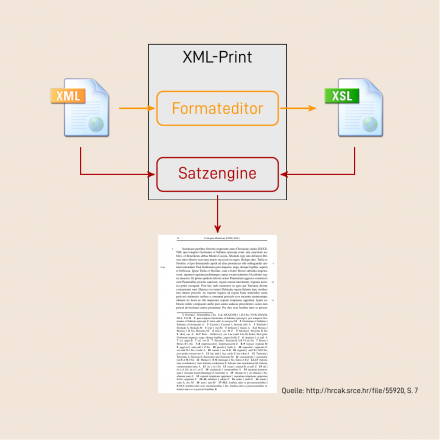XML Print
A module for Printing Scientific Texts with Complex Typesetting Layout Requirements Based on XML Data

Project Management: Prof Dr Claudine Moulin (Universität Trier - Germanistik (Ältere deutsche Philologie)) · Prof. Dr. Andrea Rapp (Technische Universität Darmstadt – Institut für Sprach- und Literaturwissenschaft (linglit)) · Dr Thomas Burch (Universität Trier - Trier Center for Digital Humanities (TCDH)) · Universität Trier - Trier Center for Digital Humanities (TCDH) · Prof. Dr. Marc Wilhelm Küster (Hochschule Worms) · Hochschule Worms
Project Participants: Hochschule Worms
Sponsors: Deutsche Forschungsgemeinschaft (DFG)
Running time: -
Contact person (TCDH): Dr Thomas Burch
References:
Martin Sievers; Thomas Burch; Marc Wilhelm Küster; Claudine Moulin; Andrea Rapp; Roland Schwarz; Yu Gan: XML-Print. An Ergonomic Typesetting System for Complex Text Structures. In: Jan Christoph Meister (Hrsg.): Digital Humanities 2012. Conference Abstracts. 1. Ausgabe, Hamburg 2012, S. 375–379.
Martin Sievers: “XML-Print – typesetting arbitrary XML documents in high quality.” Long paper at the conference “DH 2014.” University of Lausanne. Lausanne
Research Area: Software Systems and Research Infrastructure
Keywords: Tools for Editions
Website of the Project: XML Print
With a Special Focus on the Requirements of Critical Editions and Dictionaries
The aim of the “XML-Print” project was to develop a grid-compatible open source typesetting program based on XML data that meets the requirements for typesetting scientific documents. Special attention was paid to texts with complex layout requirements such as critical editions or dictionaries. In contrast to existing typesetting programs with a graphical user interface, the user works directly with semantically annotated data without first having to transfer them to a program-specific layout system. The program supports him with a modern graphical user interface in the creation of stylesheets for rule-based formatting of his data and thus enables output in a print-ready format such as PDF. This also includes complex structures - from multidirectional fonts to parallel printing with several devices.
An essential requirement of the project as a whole was to build as much as possible on existing standards (XML, XSLT, XSL-FO) for all stages of the work and to only add your own extensions where the requirements make it necessary. The use of free libraries such as Cairo or Pango also pursues this goal.
The graphical user interface was designed from the TCDH team (Yu Gan and Martin Sievers) as an Eclipse plug-in and is accordingly implemented in Java. The underlying typesetting component, on the other hand, is implemented using .NET or Mono in the F# programming language.
The entire software should become an integral part of the “TextGridLab”, but at the same time be available as a web service and standalone variant.

